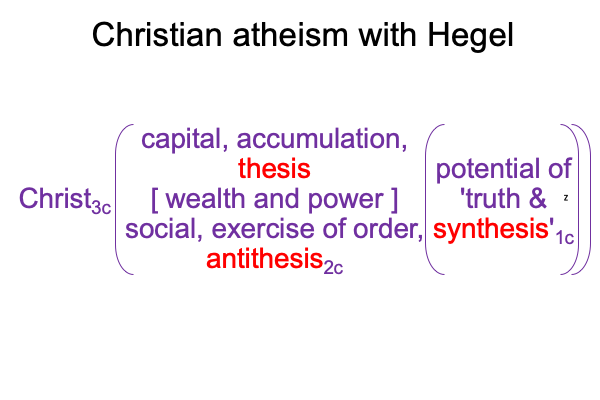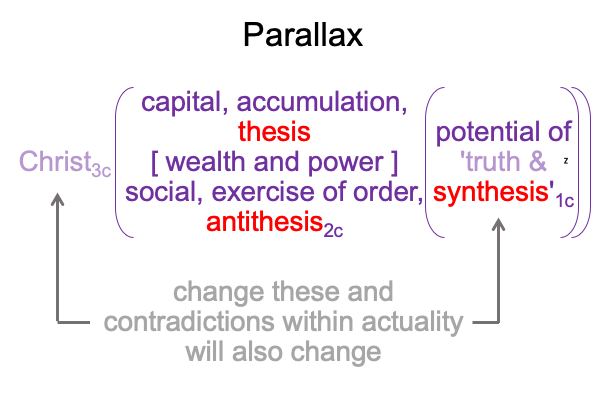0066 Before I step further into chapter one, I must take a guess as to where Hegel’s term, “synthesis” resides.
In one way, “synthesis” resides in the normal context3. In another way, it resides in the potential1, along with ‘truth’1. Since, the [substance] of [wealth and power]2 emerges from (and situates) its potential1, then there must be something more than ‘honesty’1 in ‘truth’1, ‘Truth’1 must be accompanied with ‘something substantial’, that is, ‘synthesis’1.
Here is the resulting nested form.

0067 Chapter one opens with a question, “Who cannot handle the truth?”
May I point to those with capital and organizational excess, as well as to those with social influence and institutional excess?
Oh, those excesses. It seems as if the former pulls the contiguity upwards by reifying [wealth] and the latter drags the contiguity downwards by reifying [power].
0068 Zizek, for his part, associates “truth” with a normative picture of a state of accord. Accord of what? Accumulation and order? Thesis and antithesis? As such, truth1… and its synthesis1… develops within a particular historical reality2… that is… a particular civilizational moment2.
0069 Does Lacan’s term, jouissance, associate to the potential of ‘truth and synthesis’1?
It may well do so. For Christians, the [substance] that is contiguous with Father and Son is historically contingent. Why? One God has only one opportunity to actually enter the flow of the eternal present. If God enters the flow of the eternal present multiple times, then each time He produces a new dyad, a new historically contingent “timestamp”, if you will. Each timestamp is a divine mediation.
0070 It is not that timestamps do not abound in Christian… er… Jewish revelation. There is Adam (corresponding to the start of the Ubaid archaeological period), Noah (touching base with the Uruk), and Abraham (pointing to the end of the Sumerian civilization), followed by Moses and King David. Then, the exile to Babylon, followed by a return. Construction on the Second Temple begins. During this time, the five books of Moses come together like never before. Yet, no one imagines that the Pentateuch would one day be labeled, “the Old Testament”.
0071 All these timestamps constitute a thesis, and Jesus marks the antithesis.
Now, even though the substance (that is, the contiguity) of Father and Son2 will change, depending on the winds of the Holy Spirit3, the potential of ‘truth and synthesis’1 becomes more and more apparent. The synthesis1 includes the potential of one God1. The potential of one God1 reminds me of Zizek’s use of the term, “parallax”. From one location, I see the Father as matter and thesis. I see the Son as form and antithesis. But, from another location, the Speaker is matter and the Word is form. Thesis and antithesis depends on where I stand.
Here, the terms, “thesis” and “antithesis” are bound, into a thing2, by a substance. That substance includes [begat] and [dies with]. Father and Son are two real elements that, in theory, are distinct and separable, just like the real elements of matter and form are theoretically distinct and separable. But, they cannot be separated without losing sight of the thing itself2.
0072 When we lose track of the thing itself2, we cannot understand.
Where have the normal context3 and potential1 gone?
0073 Zizek mentions an “irreducible oscillation”. Here, the oscillation is among matter [and] form2, particle [and] wave2, Father [and] Son2, capital [and] social2, accumulation [and] the exercise of order2. The oscillation is irreducible because that is the nature of Peirce’s category of secondness. Secondness consists of two contiguous real elements. One real element cannot be reduced to the other real element. Secondness follows the logics of contradiction and noncontradiction.
What is disturbing about secondness?
What is contradictory2 and what is not contradictory2 will change with the normal context3 and potential1.
0074 What does this disturbance imply?
Zizek’s parallax belongs to the realm of potential1. “Parallax” labels the optics of a monadic unity that underlies a quizzical dyadic actuality2 that changes with its normal context3.

